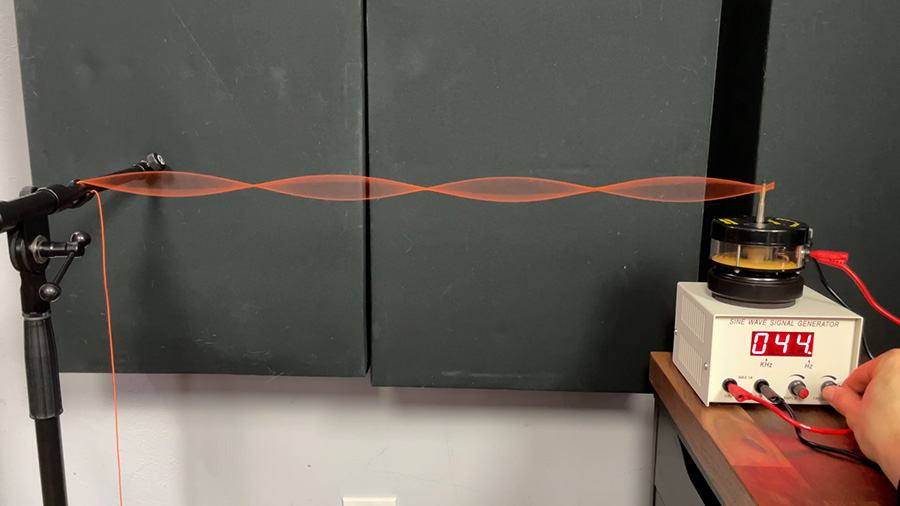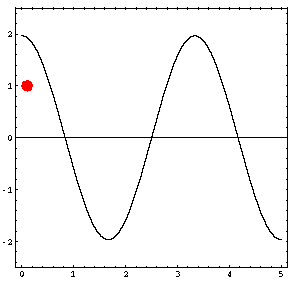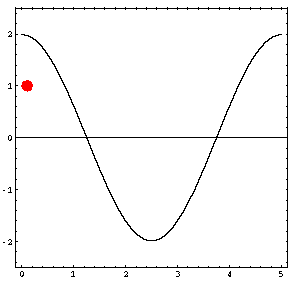In the video above, I play an 80 Hz tone through my speakers…. It doesn’t sound any different than you’d expect at first, but when I move your “ears” (a binaural microphone) around the room, the 80 Hz tone seems to disappear!
It may sound like the tone stopped playing through the speakers when you reach my listening position… But that’s just an illusion. If we step back again, you’ll hear that the tone is still playing.
This illusion is a result of one of the most essential problems in acoustics – room modes.
What Is A Room Mode?
The room modes in your listening space are directly related to the dimensions of your room. Here is a room mode calculator to determine the room modes in your room.

In my room, the distance from the front wall to the back wall is about 14 feet, which corresponds to the wavelength of an 80 Hz sound wave. There are also room modes at frequencies above and below 80 Hz at various divisions of that 14-foot dimension.
And, in addition to standing waves that are created between the front and back wall, there are also standing waves that occur between the sidewalls as well as between the floor and ceiling.

Room Mode Demonstrations
Let’s set up a few demonstrations so that we can visualize what’s going on here…

This spring is attached to a fixed point on one end. When I move the spring, a wave travels to the other end and reflects back to me.
This animation by Dr. Dan Russell might make it easier to see what’s happening in slow motion:

When I oscillate the spring at its resonant frequency, the reflections will reinforce the waves I’m creating which causes a buildup of energy at the corresponding wavelength.
This can also be demonstrated using a string that is fixed on one end and attached to a transducer on the other end.

Let’s look at one more demonstration. Up until this point, we’ve been looking at transverse waves, where the medium – the strings and springs – have moved pendicular to the direction of the wave.
However, sound waves are longitudinal, meaning the medium vibrates parallel to the direction the wave travels. This next demonstration should give us a better visualization of what standing longitudinal waves would look like.

This spring represents the air in your listening space. At the top is a fixed point, similar to the walls of your room. I’ll attach the bottom of the spring to the transducer so that we can observe how the spring reacts to various frequencies.
As we approach 30 Hz, the spring becomes visibly divided into sections, or harmonics, of the total length of the spring. The same thing happens at double that frequency – 60 Hz.
This is what happens in your room, though instead of just one dimension there are three dimensions – floor to ceiling, front to back, and side to side.
While these axial room modes which occur between two surfaces are most important to address, your room also has its own unique tangential modes which occur between 4 surfaces and oblique modes between all 6 surfaces of a rectangular room.
How To Treat Room Modes In Your Studio
Standing waves drastically affect the frequency response of your system, making it difficult to mix or listen critically because what you’re hearing at the listening position is different from what’s actually playing through your speakers…
Nodes and antinodes will form, changing the frequency response throughout your space.
In my case, I might have the tendency to boost 80 Hz because there is a node at 80 Hz at the listening position in my room. But no matter how much I turn it up, although it will become louder at the antinodes, it won’t seem to do anything at the listening position.
And it’s not only 80 Hz, it’s also the other modes in this dimension plus all of the modes in the other directions.
In terms of standing waves, we need to focus our attention on the low-frequency range up to the Schroeder frequency of room. The Schroeder frequency of a room describes the point where the room transitions from being a resonator to being a reflector or diffuser.
So, how do we address this? Well, assuming you don’t have the option to tear down your walls and rebuild the room with different geometry, here are a few ideas…
Speaker Location
In addition to the listening position, the position of the source (or speaker) can also play a part in the frequency response of your sound system. You can adjust the position of your speakers with room modes in mind.
Dr. Russell also has an animation that illustrates this…



This red dot represents the location of your speaker within your room. This helps us visualize the response of the room at each speaker position throughout the length of the room. Take notice of a few things here…
First, notice that the room response at each resonant frequency is maximized when the source is at the boundaries of the room – when your speakers are against a boundary, the standing wave resonance will be exacerbated.
Also notice that the room theoretically doesn’t respond to the resonant frequency at all when the speaker is located in one of the nodes.
You can use this knowledge to your advantage by placing the speakers somewhere between the antinode and the node of the standing wave to achieve the optimal frequency balance.
Acoustic Treatment
You can also address room mode problems with acoustic treatment. But the relatively long wavelengths of these low frequencies will require a slightly different approach compared to higher frequencies.
The effectiveness of velocity-based porous absorbers such as the panels on my walls depends on the thickness of the panel in comparison to the wavelength of the frequency it’s trying to absorb. That means the thickness of the panel determines how effectively it absorbs low frequencies with longer wavelengths.
If I were to try to treat 80 Hz with a velocity absorber like this, it would take up an impractical amount of space in my room to achieve the required thickness. Not only that, but too much absorption may begin to absorb too much mid and high frequencies which doesn’t really help in terms of frequency balance – the ultimate goal.
That said, using bass traps in the corners is a good start for combating low-frequency build-up. Just keep in mind that their effectiveness will also diminish at lower frequencies.
As opposed to velocity-based absorbers, you can get more effective absorption using pressure-based solutions like Helmholtz resonators.
These are specially designed to target a narrow band of frequencies as opposed to the broadband absorbers on my walls. Because of this, it’s important to purchase resonators that are specifically designed to address the frequencies which are particularly problematic in your room.
If you want some help figuring out a plan to treat room modes and improve the acoustics of your room, check out GIK Acoustics and Sweetwater. They will be able to give you specific suggestions based on the unique characteristics of your room.
